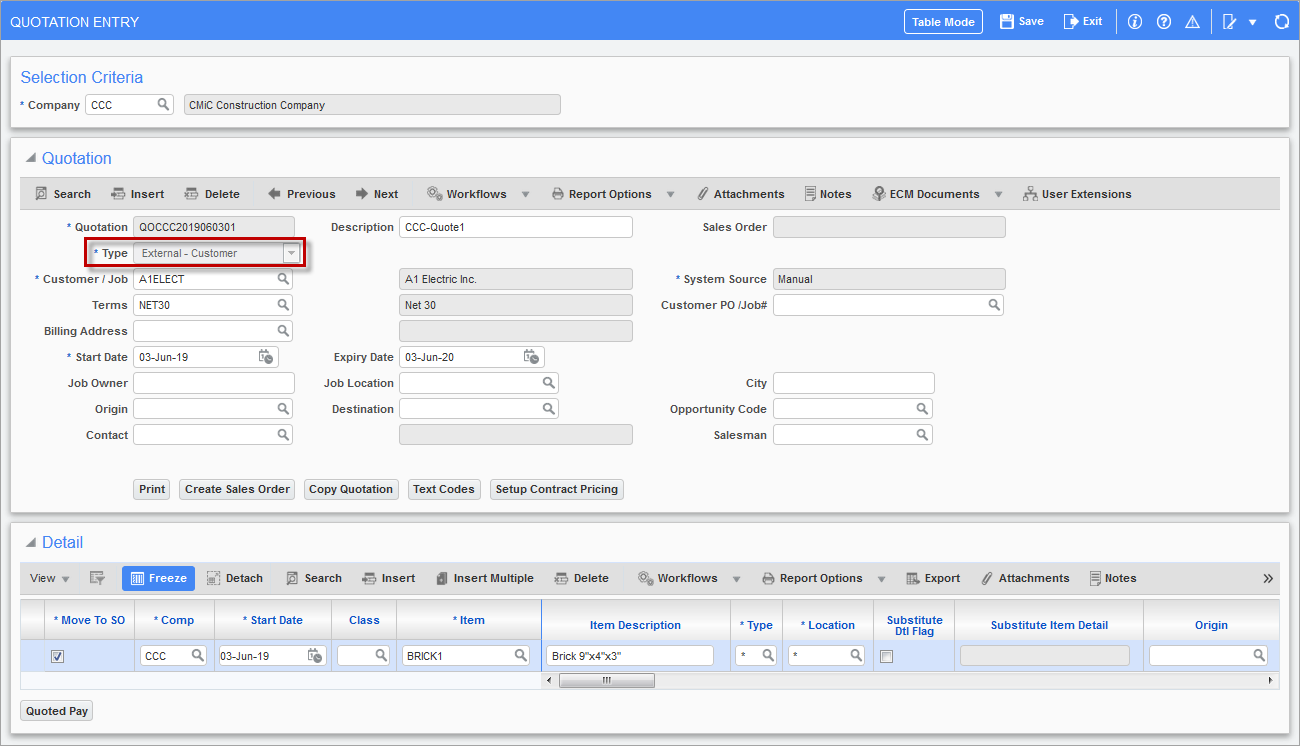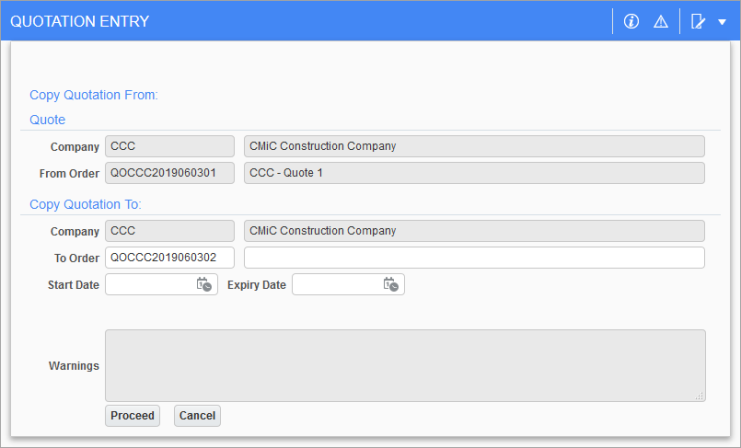
Pgm: MS_SALES_ORDER_ENTRY_QUOTATION – Quotation Entry; standard Treeview path: Material Sales > Sales Order > Quotation Entry
Selection Criteria
Company
Enter the company code for the sales order type.
Quotation
Quotation
Enter a quotation code and description to reference the quotation. The quotation code and description will copy exactly to the sales order when it is created. The System Source field will display “Manual” indicating that the data is entered manually. Quotations are always manual. However, this field will be used by the sales order that can be entered manually or imported.
Type
Select the customer type. To create an external quotation, set the Type field to “External – Customer”. For internal quotation, the Type field should be set to “Internal – Job”.
Customer/Job
Enter the customer code.
Customer PO/Job #
Enter the PO number associated with this customer. This is a customer defined PO number and is free-form text.
Terms
Select the payment terms for this customer. This will default from the customer’s payment terms defined in AR.
Billing Address
If there is an alternate address to be used for billing, select it from the LOV. It will default from the customer’s additional addresses.
Job Owner
Enter the name of the job owner.
Job Location
Enter the job location. This is usually the job site.
City
Enter the city where the job will be located.
Origin
Enter the origin. The origin is usually the material production site, such as a plant or quarry, but it may be a job site. The origin is not a mandatory field as it may not be known at the time the quotation is entered.
Destination
Enter the destination. This field defaults from the job location. The destination is usually a job site but the quotation may be issued for hauling from a job to a dump, etc.
Contact
Enter the contact.
Opportunity Code
This LOV lists the opportunities for the customer denoted in the sales order. Any opportunity selected is used for informational purposes only.
Salesman
Enter the salesman’s employee number.
Start Date
Enter the start date of the quotation.
Expiry Date
Enter the expiry date of the quotation.
[Notes] – button
Notes may be entered using the [Notes] button on the Block Toolbar for information regarding the whole quotation. Notes are for internal use and will not print on the quotation.
[Print] – Button
Use the [Print] button to print the quotation currently on the screen.
[Text Codes] – Button
The [Text Codes] button will show a pop-up window allowing the entry and description of three text codes. This information will print in the header of the quotation.
[Create Sales Order] – Button
This button opens a pop-up window to confirm if the user wants to convert the quotation into a sales order.
[Copy Quotation] – Button

Pgm: MS_SALES_ORDER_ENTRY – Copying a Quotation
A quotation can be copied to another quotation by clicking the [Copy Quotation] button. A prompt is displayed for the new quotation code. Enter the new quotation code. A new quotation is created with the same data as the quotation from which it was copied.
[Setup Contract Pricing] – Button
This button opens a pop-up window and allows users to enter values specific to a contract, which will be defaulted into a detail line when created. Users can override the values as required. During ticket entry, the values set in the contract pricing will set the rules to calculate some of the values such as trucker pay discount percent.
Detail
Move To SO – Checkbox
If this box is checked, a sales order detail item will be created from the quotation detail item.
Comp
Enter company code.
Start Date
Enter the start date for the specific material for a price list lookup. This date should be on or after the start date of the quotation.
Class
Class is for an inventory item only. If an inventory item is being quoted, a class must be entered.
Item
Select the item from the LOV. If a class has not been entered the item selection will be limited to purchase order non-stock items or Accounts Receivable non-stock items. The item code will play a key role in the search of the customer price list’s unique combination of item, location, type, and weight measure code. When using a non-stock item from either Purchase Order or Accounts Receivable, the only two combinations required are item and weight measure code.
Type
Type is for an inventory item only. The type may play a key role in the search of the customer price list’s unique combination of item, location, type, and weight measure code. If the item is a non-stock item, the field will populate with an asterisk when the user tabs past it.
Location
Select the item location.
Substitute Dtl Flag – Checkbox
Check or uncheck the substitution flag if applicable.
Origin
Enter the origin of the job.
Destination
Enter the destination of the job.
Expiry Date
Enter the expiry date.
Total AC %
Enter the override AC percentage.
Index Amount
Enter the selling price index amount.
Max Protection %
Enter the maximum protection percentage.
Min Protection %
Enter the minimum protection percentage.
Quantity
Enter the quantity being quoted.
WM
Enter the weight/measure code being quoted. The weight/measure code will play a key role in the search of the customer price list’s unique combination of item, location, type, and weight/measure code. When using an AR non-stock or PO non-stock item, the only two combinations required are item and weight/measure code.
Price
The price will default from the customer price list search by item and default order for an item in the price list. The price can be overwritten in the quotation price field.
Amount
The amount will be calculated as price × quantity.
Disc%
Enter the discount percent on the amount if not entering a discount per WM.
Disc/WM
Enter the discount per WM if not entering a discount percent. This is the discount dollar amount for every unit of WM entered as the quantity.
Zone Pricing
Enter the zone pricing code to be applied to the quotation.
From Zone, To Zone
Enter the range of zone codes to be applied to the quotation.
Tax1, Tax2, Tax3
Enter the tax codes to be applied to the quotation.
Trucker Class
Enter the trucker vendor class code if applicable.
Truck Class
Enter the truck class code if applicable.
Pay Rate
Enter the pay rate to be paid to the trucker for delivery of the item. The trucker may be an internal trucker or external trucker including sub-haulers. Pay rate should be entered only if the trucker is an external trucker or sub-hauler.
Min Pay Qty
Enter the minimum pay quantity.
Min Pay Amount
Enter the minimum pay for truckers.
Trucker Pay
This displays the trucker pay.
Trucker Pay Surcharge %
Enter trucker pay surcharge percentage.
Pay Surcharge Rate
Enter trucker pay surcharge per WM.
Pay Lump Sum Amount
Enter the pay lump sum amount.
Trucker Pay Surcharge
This displays the trucker pay surcharge.
Delivery Charges Rate
Enter the delivery charges per WM.
Min Charges Qty
Enter the minimum quantity required for delivery.
Min Charges Amount
Enter the minimum charge required for delivery.
Delivery Charges
This displays the delivery charges.
Delivery Surcharge %
Enter the delivery surcharge percentage.
Charges Surcharge Rate
Enter the delivery surcharge rate per WM.
Lump Sum Amount
Enter the delivery surcharge lump sum amount.
Delivery Charges Surcharge
This displays the delivery charges surcharge.
Bid Margin
Enter the bid margin for the quote item.
Delivery Charge Tax1, Tax2, Tax3
Enter the delivery charge taxes.
Delivery Surcharge Tax1, Tax2, Tax3
Enter the delivery surcharge taxes.